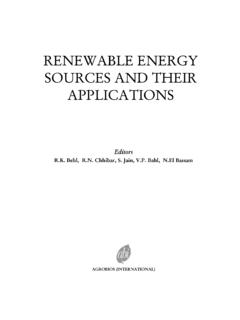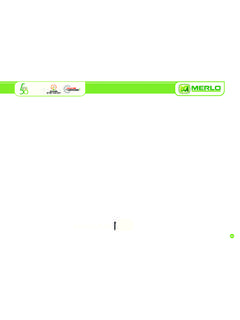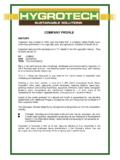Transcription of 5 NOISE SOURCES - World Health Organization
1 5. NOISE SOURCES . Professor Samir Gerges Gustav A. Sehrndt* and Wolfgang Parthey Federal University of Santa Catarina Federal Institute for Occupational Mechanical Engineering Department Safety and Health NOISE and Vibration Laboratory Friedrich-Henkel-Weg 1-25. - Florian polis - SC 44149 Dortmund BRAZIL GERMANY. INTRODUCTION. Industrial machinery and processes are composed of various NOISE SOURCES such as rotors, stators, gears, fans, vibrating panels, turbulent fluid flow, impact processes, electrical machines, internal combustion engines etc. The mechanisms of NOISE generation depend on the particularly noisy operations and equipment including crushing, riveting, blasting (quarries and mines), shake-out (foundries), punch presses, drop forges, drilling, lathes, pneumatic equipment ( jack hammers, chipping hammers, etc.), tumbling barrels, plasma jets, cutting torches, sandblasting, electric furnaces, boiler making, machine tools for forming, dividing and metal cutting, such as punching, pressing and shearing, lathes, milling machines and grinders, as well as textile machines, beverage filling machines and print machines, pumps and compressors, drive units, hand-guided machines, self-propelled working machines, in-plant conveying systems and transport vehicles.
2 On top of this there are the information technology devices which are being encountered more and more in all areas. NOISE is therefore a common occupational hazard in a large number of workplaces such as the iron and steel industry, foundries, saw mills, textile mills, airports and aircraft maintenance shops, crushing mills, among many others. In many countries, NOISE -induced hearing loss is one of the most prevalent occupational diseases. According to a Environmental Protection Agency (EPA)/USA report in 1981, there are more than nine million Americans exposed to a daily average occupational NOISE level above 85 dB(A); this number has increased to about 30 million in 1990. Most of these workers are in the production and manufacturing industries (see Table ). Studies in Germany and other industrialized countries have shown that the proportion of those exposed to daily average NOISE levels above 85 dB(A) can generally be taken as 12 % to 15% of all employed persons; that is 4 to 5 million persons in Germany (Pfeiffer 1992).
3 After many years of exposure to NOISE , there are numerous cases of occupationally related hearing damage recognized _____. * Present address: Gustav A. Sehrndt, NOISE Control Consultant Niesertstr. 42. 48145 Muenster, Germany 104 NOISE SOURCES Table Workers exposed to daily LAeq exceeding 85 dB(A). (EPA, 1981). agriculture 323000. Mining 400000. Construction 513000. Manufacturing and 5124000. Utilities Transportation 1934000. Military 976000. Total 9270000. as the occupational disease " NOISE -related hearing impairment" according to the Occupational Diseases Ordinance. An acquired NOISE -related hearing impairment which leads to a reduction in earning ability of 20 % and more is compensated for in Germany in the form of a pension. Table shows the high percentages of those with impaired hearing due to NOISE in relation to other selected occupational diseases. Table Number and percentages for some selected occupational diseases/disorders in 1998 (total in Germany, from BMA, 1999).
4 Cases registered cases recognized cases registered for first time for first time & indemnified without indemnity for first time (reduction of earning ability 20%). Occupational number % number % number %. diseases/disorders meniscus 2398 418 275 damage from vibrations 1797 234 154 impaired hearing 12400 7439 1012 silicosis 2813 2100 391 skin disorders 23349 1855 582 NOISE SOURCES 105. A cross-section analysis in Germany of working equipment and processes in operational NOISE areas with a hearing impairment hazard has shown that 80 % of the - several million - sound SOURCES can be attributed to machine operations, conveying systems, control and regulation devices and turbo machines, while 20 % are accounted for by manual working and conveying operations. About three quarters of the machine operations can be attributed to machine tools (Damberg, Foss 1982). The main concern of NOISE control is therefore the development, production and preferred use of low- NOISE working equipment and processes.
5 The avoidance or minimization of Health hazards in the working process by the appropriate design of working equipment and processes, in other words by prevention, has also been elevated to a principle on an European level. With the establishment of regulations concerning the nature of machines, devices and installations in EU Directives and more specific European standards, it can be assumed that there is a high level of safety, Health and consumer protection. This NOISE control principle is manifested in the definition and declaration of NOISE characteristics for products or machines and the description of achievable values by the standards. INDUSTRIAL NOISE SOURCES . In this section, the fundamental mechanisms of NOISE SOURCES are discussed, as well as some examples of the most common machines used in the work environment. The sound pressure level generated depends on the type of the NOISE source, distance from the source to the receiver and the nature of the working environment.
6 For a given machine, the sound pressure levels depend on the part of the total mechanical or electrical energy that is transformed into acoustical energy. Sound fields in the workplace are usually complex, due to the participation of many SOURCES : propagation through air (air-borne NOISE ), propagation through solids (structure-borne NOISE ), diffraction at the machinery boundaries, reflection from the floor, wall, ceiling and machinery surface, absorption on the surfaces, etc. Therefore any NOISE control measure should be carried out after a source ranking study, using identification and quantification techniques. The basic mechanism of NOISE generation can be due to mechanical NOISE , fluid NOISE and/or electromagnetic NOISE (Allen, 1970 and ISO/TR 11688). The driving force for economic development is mainly the endeavour to produce consumer goods ever more cost-effectively. From the point of view of the machine manufacturer, this generally means offering products with a low space, material, energy and production time requirement (smaller, lighter, more economical and more productive).
7 At the same time account is being taken increasingly of resource conservation and environmental friendliness, although the rise in NOISE levels which frequently goes along with increased output and productivity is often overlooked. Personnel are then exposed to higher NOISE levels than before, despite NOISE -reducing measures taken in the machine's design. This is because the NOISE emission rises non-linearly because of higher rotary and travelling speeds in machine parts. For example, for every doubling of the rotary speed the NOISE emission for rotating print machines rises by about 7 dB, for warp knitting looms 12 dB, for diesel engines 9 dB, for petrol engines 15 dB and for fans is between 18 to 24 dB. For the purpose of comparison: the doubling of sound power produces an increase in emission of 3 dB only. But even previously quiet procedures are often replaced by loud ones for reasons of cost, stress-free vibration instead of annealing for welded parts.
8 In some cases new technologies also result in higher emissions; for example, with the use of phase-sequence-controlled electrical 106 NOISE SOURCES drives, the excitation spectrum shifts further to high frequencies, which results in a greater sound radiation from large machine surfaces. This means that some new NOISE problems are closely related to the use of modern technologies. Mechanical NOISE A solid vibrating surface, driven or in contact with a prime mover or linkage, radiates sound power (W in Watts) proportional to the vibrating area S and the mean square vibrating velocity < v 2>, given by;. W = cS 2 ra d where is the air density (kg/m3), c is the speed of sound (m/s) and rad is the radiation efficiency (see Gerges 1992). Therefore care must be taken to reduce the vibrating area and/or reduce the vibration velocity. Reducing the vibrating area can be carried out by separating a large area into small areas, using a flexible joint.
9 Reduction of the vibration velocity can be carried out by using damping materials at resonance frequencies and/or blocking the induced forced vibration. A reduction of the excitation forces and consequently of the vibration velocity response by a factor of two can provide a possible sound power reduction of up to 6 dB assuming that the other parameters are kept constant. Typical examples of solid vibration SOURCES are: eccentric loaded rotating machines, panel and machine cover vibration which can radiate sound like a loudspeaker, and impact induced resonant free vibration of a surface. Fluid NOISE Air turbulence and vortices generate NOISE , especially at high air flow velocities. Turbulence can be generated by a moving or rotating solid object, such as the blade tip of a ventilator fan, by changing high pressure discharge fluid to low (or atmospheric) pressure, such as a cleaning air jet or by introducing an obstacle into a high speed fluid flow.
10 The aerodynamic sound power generated by turbulent flow is proportional to the 6th to 8th power of the flow velocity (W U6 to 8), which means that a doubling of the flow velocity (U). increases the sound power (W) by a factor of 64 to 254 or 18 to 24 dB respectively. Table shows the effects of doubling of the typical velocity together with other primary mechanisms. Therefore care must be taken to reduce flow velocity, reduce turbulence flow by using diffusers and either remove obstacles or streamline them. The next few examples show the applications of these fundamental concepts to machinery NOISE reductions. NOISE SOURCES 107. EXAMPLES OF MACHINERY NOISE SOURCES . In this section, NOISE SOURCES are presented for the most common machines used in industrial installations. For each case, the mechanism of NOISE generation is discussed. Industrial Gas Jets Industrial jet NOISE probably ranks third as a major cause of hearing damage after that of impact and material handling NOISE .

















